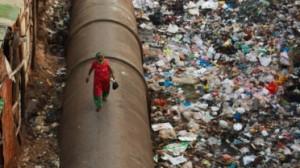A new article examining the increasing inequalities around water provision in Delhi by STEPS Centre partner Alankar is published this week.
provision in Delhi by STEPS Centre partner Alankar is published this week.
Socio-Spatial Situatedness and Access to Water (Economic & Political Weekly, October 12, 2013 vol xlviiI 54 no 41), looks at the social and political biases around large state-managed and institutionalised water provision in the city and the increasing gap between the haves and have-nots.
In the nearby Trans Hindon area, Alankar finds there are huge disparities in terms of formal and even informal water access. Both regions are seeing rising levels of deprivation among some and increasing affluence among others, reflected in the distribution and availability of water to these populations.
“This paper examines access to water in two geographic regions: Delhi and Trans Hindon area (THA) of the adjoining city of Ghaziabad. Contrary to public policy and new management strategies that derive from the notion of absolute scarcity, the paper argues that in the urban scenario of developing countries the “publicness” of public utility only gestures towards uniformity and universality. It actually reinforces the socio-economic inequities and disparities as these exist in current urban contexts.
“Thus, the paper tries to contextualise the meaning of socio-spatial situatedness as intertwined with the effective understanding of public utility. Although the term public connotes universal and to a large extent uniform service provisioning but as demonstrated in the following two area studies, the “publicness” of public utilities is restricted to middle- and upper-class citizens located in formal and planned enclaves. The numerically superior poor, situated in the densely populated informal, unauthorised and “illegal” spaces are either excluded from the utility’s services or remain largely underserved.”
Alankar ([email protected]) was at the School of Environmental Studies, Jawaharlal Nehru University, New Delhi and worked with the STEPS Centre’s project Urbanisation in Asia: the peri-urban interface and sustainability of south Asian cities
This project looked at water conflicts in areas on the edge of Delhi, to explore technological and environmental sustainability challenges in peri-urban areas where powerful actors benefit from the lack of regulation and marginalised people lack access to basic health, water and sanitation services.
Another article looking at this issue was recently published in the journal Geoforum by the co-convenor of the peri-urban project, Lyla Mehta, along with Jeremy Allouche, Alan Nichol and Anna Walnycki, Global environmental justice and the right to water: The case of peri-urban Cochabamba and Delhi.
By drawing on local people’s experiences and mobilisations around water in peri-urban localities in Bolivia and India, the article examines the contradictions around the implementation of the right to water in charged peri-urban spaces.
“This article applies the global environmental justice (GEJ) approach to the problem of universal access to safe and potable water. Nowhere is the challenge more pressing than in peri-urban spaces where the lack of formal water provision and increasing environmental pollution lead to significant challenges for human wellbeing. We examine how and whether global discourses concerning the human right to water can be strengthened by resorting to GEJ, not least to allow for sustainable human–environmental interaction, in order to meet growing water needs in rapidly expanding urban areas.”